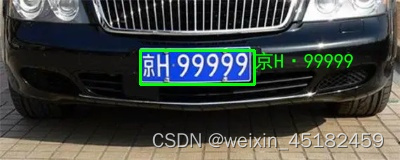车牌识别包括车牌检测(通过图像分割、特征提取获得车牌位置)+车牌识别(对检测到的车牌进行字符内容识别)。
一、基本流程如下:
1.车牌检测
1)读取需要进行车牌识别的图片;
2)对图像进行灰度化处理(高斯模糊可选择是否进行)和灰度拉伸;
3)进行开运算,消除图像中的噪声;
4)将灰度拉伸后的图像和开运算后的图像求差,并输出其绝对值;
5)将图像二值化,并利用Canny边缘算法提取图像中边缘轮廓;
6)进行闭运算操作,获得小连通域;
7)进行两次开运算操作,获得大连通域;
8)利用车牌长宽比筛选可能属于车牌区域的框,在原图中绘制矩形 。
2.车牌字符识别
1)对车牌ROI图像进行灰度化处理;
2)利用形态学运算中的闭运算消除灰度图像噪声点;
3)利用百度飞桨OCR识别车牌字符与位置;
4)将结果打印并在图片上显示出来。
二、实际代码测试:
1.输入图像:

2.输出图像:

三、注意事项
1.目前代码进行过单个车牌检测,未对多个车牌进行检测;
2.paddleOCR下载和配置,且容易出错,实际使用中速度较慢,可考虑使用EASYOCR作为代替。
附上代码
import cv2
from matplotlib import pyplot as plt
import os
import numpy as np
from paddleocr import PaddleOCR, draw_ocr
from PIL import Image, ImageDraw, ImageFont
#利用paddelOCR进行文字扫描,并输出结果
def text_scan(img_path):
ocr = PaddleOCR(use_angle_cls=True, use_gpu=False)
#img_path = r'test image/license_plate1.jpg'
result = ocr.ocr(img_path, cls=True)
for line in result:
#print(line)
return result
#在图片中写入将车牌信息
def infor_write(img,rect,result):
text=result[1][0]
cv2img = cv2.cvtColor(img, cv2.COLOR_BGR2RGB) # cv2和PIL中颜色的hex码的储存顺序不同
pilimg = Image.fromarray(cv2img)
#PIL图片上打印汉字
draw = ImageDraw.Draw(pilimg) # 图片上打印
font = ImageFont.truetype("simhei.ttf",20, encoding="utf-8") # 参数1:字体文件路径,参数2:字体大小
draw.text((rect[2], rect[1]), str(text), (0,255,0), font=font) # 参数1:打印坐标,参数2:文本,参数3:字体颜色,参数4:字体
#PIL图片转cv2 图片
cv2charimg = cv2.cvtColor(np.array(pilimg), cv2.COLOR_RGB2BGR)
return cv2charimg
#图像去噪灰度处理
def gray_guss(img):
img=cv2.GaussianBlur(img,(1,1),0)
gray=cv2.cvtColor(img,cv2.COLOR_BGR2GRAY)
return gray
#图像尺寸变换
def img_resize(img):
a=400*img.shape[0]/img.shape[1]
a=int(a)
img=cv2.resize(img,(400,a))
return img
#Sobel检测,x方向上的边缘检测(增强边缘信息)
def Sobel_detec(img):
Sobel_x = cv2.Sobel(img, cv2.CV_16S, 1, 0)
absX = cv2.convertScaleAbs(Sobel_x)
return absX
#寻找某区域最大外接矩形框4点坐标
def find_retangle(contour):
y,x=[],[]
for p in contour:
y.append(p[0][0])
x.append(p[0][1])
return [min(y),min(x),max(y),max(x)]
#寻找并定位车牌轮廓位置
def locate_license(img):
blocks=[]
contours,hierarchy=
cv2.findContours(img,cv2.RETR_EXTERNAL,cv2.CHAIN_APPROX_SIMPLE)
for c in contours:
x,y,w,h=cv2.boundingRect(c)
r=find_retangle(c)
a=(r[2]-r[0])*(r[3]-r[1])#r=[min(y),min(x),max(y),max(x)]
s=(r[2]-r[0])/(r[3]-r[1])
#根据轮廓形状特点,确定车牌的轮廓位置并截取图像
if (w> (h * 3)) and (w < (h * 5)):
# img=oriimg[y:y+h,x:x+w]
# cv2.rectangle(oriimg, (x, y), (x+w, y+h), (0, 255, 0), 2)
blocks.append([r, a, s])
# 选出面积最大的3个区域
blocks = sorted(blocks, key=lambda b: b[1])[-3:] # 按照blocks第3个元素大小进行排序
# 使用颜色识别判断出最像车牌的区域
maxweight, maxindex = 0, -1
# 划分ROI区域
for i in range(len(blocks)):
b = oriimg[blocks[i][0][1]:blocks[i][0][3], blocks[i][0][0]:blocks[i][0][2]]
# RGB转HSV
hsv = cv2.cvtColor(b, cv2.COLOR_BGR2HSV)
# 蓝色车牌范围
lower = np.array([100, 50, 50])
upper = np.array([140, 255, 255])
# 根据阈值构建掩模
mask = cv2.inRange(hsv, lower, upper)
# 统计权值
w1 = 0
for m in mask:
w1 += m / 255
w2 = 0
for w in w1:
w2 += w
# 选出最大权值的区域
if w2 > maxweight:
maxindex = i
maxweight = w2
# print(blocks[maxindex][0])
return blocks[maxindex][0]#blocks[maxindex][0]即为车牌轮廓位置理想外轮廓
#图像预处理+车牌轮廓位置检测
def fine_lisecenpts(img):
# 图像去噪灰度处理
guss = gray_guss(img)
# Sobel检测,增强边缘信息
sobel = Sobel_detec(guss)
# 图像阈值化操作——获得二值化图
ret, threshold = cv2.threshold(sobel, 0, 255, cv2.THRESH_OTSU)
# # 对二值化图像进行边缘检测(可选,通过边缘检测后,最终进行形态学运算得到的轮廓面积更大)
# threshold=cv2.Canny(threshold,threshold.shape[0],threshold.shape[1])
#形态学运算(从图像中提取对表达和描绘区域形状有意义的图像分量)——闭操作
kernelX = cv2.getStructuringElement(cv2.MORPH_RECT, (30, 10))
closing = cv2.morphologyEx(threshold, cv2.MORPH_CLOSE, kernelX, iterations=1)
# 腐蚀(erode)和膨胀(dilate)
kernelX=cv2.getStructuringElement(cv2.MORPH_RECT,(50,1))
kernelY=cv2.getStructuringElement(cv2.MORPH_RECT,(1,20))
#x方向上进行闭操作(抑制暗细节)
img=cv2.dilate(closing,kernelX)
img=cv2.erode(img,kernelX)
#y方向上进行开操作
img=cv2.erode(img,kernelY)
img=cv2.dilate(img,kernelY)
#进行中值滤波去噪
Blur=cv2.medianBlur(img,15)
#寻找轮廓
rect=locate_license(Blur)
return rect,Blur
#车牌字符识别
def seg_char(rect_list,img):
img=oriimg[rect_list[1]:rect_list[3], rect_list[0]:rect_list[2]]
# 图像去噪灰度处理
gray=gray_guss(img)
# 图像阈值化操作-获得二值化图(可选)
#ret,charimage=cv2.threshold(gray,0,255,cv2.THRESH_BINARY_INV+cv2.THRESH_OTSU)
#图像进行闭运算
k1 = np.ones((1, 1), np.uint8)
close = cv2.morphologyEx(gray, cv2.MORPH_CLOSE, k1)
cv2.imshow('close', close)
cv2.imwrite('test image/Char_img.jpg',close)
cv2.waitKey()
res=text_scan(r'test image/Char_img.jpg')
return res
#主函数区
if __name__ == '__main__':
img=cv2.imread('test image/license_plate1.jpg')
# 改变图像尺寸
img=img_resize(img)
oriimg=img.copy()
#寻找到车牌外轮廓矩形坐标
rect, img=fine_lisecenpts(img)
#利用车牌轮廓坐标划分ROI区域用于字符识别,利用OCR识别车牌字符并返回字符串内容
result=seg_char(rect,oriimg)
#循环读取车牌字符串并写入到图片中
for list in result:
oriimg=infor_write(oriimg, rect, list)
cv2.rectangle(oriimg, (rect[0], rect[1]), (rect[2], rect[3]), (0, 255, 0), 2)
cv2.imshow('oriimg',oriimg)
cv2.waitKey()文章出处登录后可见!
已经登录?立即刷新
